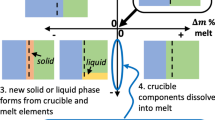Abstract
During the last decade, important improvements have been made in the application of thermodynamic models for studying the molten cryolite system used in the Hall–Heroult process. This approach allows a better understanding and paves the way for furthering developments in bath chemistry and molten metal processing. In this article, thermodynamic modeling is used to explore the operating windows in the reduction of alumina in molten cryolite. The impact of a range of concentrations of AlF3, CaF2, and Al2O3 in conventional or “lithium-free” baths is also discussed. Subsequently, the model was also used to evaluate the impact of additions of lithium fluoride to the bath. Conditions allowing an operation at lower cell voltages and lower bath temperatures were identified. The modeling approach described in this article is considered as an important innovation to revisit fundamentals, to constantly re-examine paradigms, and to identify potential modifications in bath chemistry for improving energy efficiency and productivity of modern prebaked Hall–Heroult cells.






Similar content being viewed by others
References
P. Coursol, P. Coulombe, S. Gosselin, D. Lavoie, J.-M. Simard, J. Marks, and S. Fardeau, JOM 63, 109 (2011).
P. Coursol, J. Coté, S. Gosselin, and D. Lavoie (Paper 2b1 presented at the 10th Australasian Aluminium Smelting Conference, Launceston, Australia, ed. B. Welch, G. Stephens, J. Metson, and M. Skyllas-Kazacos, 2001).
P. Coursol, J. Coté, F. Laflamme, P. Thibault, A. Blais, D. Lavoie, and S. Gosselin, Light Metals 2012, ed. C.E. Suarez (Warrendale, PA: The Minerals, Metals & Materials Society; Hoboken, NJ: John Wiley & Sons, 2012), pp. 591–594.
www.factsage.com and C.W. Bale, E. Belisle, P. Chartrand, S. Decterov, G. Eriksson, K. Hack, I.-H. Jung, Y.-B. Kang, J. Melancon, A. Pelton, C. Robelin, and S. Peterson, CALPHAD 33, 295 (2009).
P. Chartrand and A.D. Pelton, Light Metals 2002, ed. Wolfgang Schneider (Warrendale, PA: TMS, 2002), p. 245.
TMS Industrial Aluminum Electrolysis Course, 29 August to 2 September, 2011, Reykjavík, Iceland.
A. Solheim, Light Metals 2002, ed. Wolfgang Schneider (Warrendale, PA: TMS, 2002), p. 225.
Author information
Authors and Affiliations
Corresponding author
Rights and permissions
About this article
Cite this article
Coursol, P., Dufour, G., Coté, J. et al. Application of Thermodynamic Models for Better Understanding and Optimizing the Hall–Heroult Process. JOM 64, 1326–1333 (2012). https://doi.org/10.1007/s11837-012-0426-x
Received:
Accepted:
Published:
Issue Date:
DOI: https://doi.org/10.1007/s11837-012-0426-x




